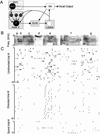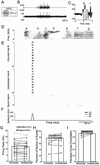Emergence of context-dependent variability across a basal ganglia network
- PMID: 24698276
- PMCID: PMC4132189
- DOI: 10.1016/j.neuron.2014.01.039
Emergence of context-dependent variability across a basal ganglia network
Abstract
Context dependence is a key feature of cortical-basal ganglia circuit activity, and in songbirds the cortical outflow of a basal ganglia circuit specialized for song, LMAN, shows striking increases in trial-by-trial variability and bursting when birds sing alone rather than to females. To reveal where this variability and its social regulation emerge, we recorded stepwise from corticostriatal (HVC) neurons and their target spiny and pallidal neurons in Area X. We find that corticostriatal and spiny neurons both show precise singing-related firing across both social settings. Pallidal neurons, in contrast, exhibit markedly increased trial-by-trial variation when birds sing alone, created by highly variable pauses in firing. This variability persists even when recurrent inputs from LMAN are ablated. These data indicate that variability and its context sensitivity emerge within the basal ganglia network, suggest a network mechanism for this emergence, and highlight variability generation and regulation as basal ganglia functions.
Copyright © 2014 Elsevier Inc. All rights reserved.
Figures








Comment in
-
Achieving perfection through variability: the basal ganglia helped me do it!Neuron. 2014 Apr 2;82(1):6-8. doi: 10.1016/j.neuron.2014.03.010. Neuron. 2014. PMID: 24698264
Similar articles
-
Neurons in a forebrain nucleus required for vocal plasticity rapidly switch between precise firing and variable bursting depending on social context.J Neurosci. 2008 Dec 3;28(49):13232-47. doi: 10.1523/JNEUROSCI.2250-08.2008. J Neurosci. 2008. PMID: 19052215 Free PMC article.
-
Singing-related neural activity distinguishes two putative pallidal cell types in the songbird basal ganglia: comparison to the primate internal and external pallidal segments.J Neurosci. 2010 May 19;30(20):7088-98. doi: 10.1523/JNEUROSCI.0168-10.2010. J Neurosci. 2010. PMID: 20484651 Free PMC article.
-
Activity in a cortical-basal ganglia circuit for song is required for social context-dependent vocal variability.J Neurophysiol. 2010 Nov;104(5):2474-86. doi: 10.1152/jn.00977.2009. Epub 2010 Sep 8. J Neurophysiol. 2010. PMID: 20884763 Free PMC article.
-
Birdbrains could teach basal ganglia research a new song.Trends Neurosci. 2005 Jul;28(7):353-63. doi: 10.1016/j.tins.2005.05.005. Trends Neurosci. 2005. PMID: 15935486 Review.
-
Variability in action: Contributions of a songbird cortical-basal ganglia circuit to vocal motor learning and control.Neuroscience. 2015 Jun 18;296:39-47. doi: 10.1016/j.neuroscience.2014.10.010. Epub 2014 Oct 18. Neuroscience. 2015. PMID: 25445191 Review.
Cited by
-
The Avian Basal Ganglia Are a Source of Rapid Behavioral Variation That Enables Vocal Motor Exploration.J Neurosci. 2018 Nov 7;38(45):9635-9647. doi: 10.1523/JNEUROSCI.2915-17.2018. Epub 2018 Sep 24. J Neurosci. 2018. PMID: 30249800 Free PMC article.
-
Unsupervised Bayesian Ising Approximation for decoding neural activity and other biological dictionaries.Elife. 2022 Mar 22;11:e68192. doi: 10.7554/eLife.68192. Elife. 2022. PMID: 35315769 Free PMC article.
-
Origins of basal ganglia output signals in singing juvenile birds.J Neurophysiol. 2015 Feb 1;113(3):843-55. doi: 10.1152/jn.00635.2014. Epub 2014 Nov 12. J Neurophysiol. 2015. PMID: 25392171 Free PMC article.
-
Discrete Circuits Support Generalized versus Context-Specific Vocal Learning in the Songbird.Neuron. 2017 Dec 6;96(5):1168-1177.e5. doi: 10.1016/j.neuron.2017.10.019. Epub 2017 Nov 16. Neuron. 2017. PMID: 29154128 Free PMC article.
-
Variable but not random: temporal pattern coding in a songbird brain area necessary for song modification.J Neurophysiol. 2021 Feb 1;125(2):540-555. doi: 10.1152/jn.00034.2019. Epub 2020 Dec 9. J Neurophysiol. 2021. PMID: 33296616 Free PMC article.
References
-
- Bar Gad I, Bergman H. Stepping out of the box: information processing in the neural networks of the basal ganglia. Curr. Opin. Neurobiol. 2001;11:689–695. - PubMed
-
- Bergman H, Feingold A, Nini A, Raz A, Slovin H, Abeles M, Vaadia E. Physiological aspects of information processing in the basal ganglia of normal and parkinsonian primates. TINS. 1998;21:32–38. - PubMed
-
- Bottjer SW, Miesner EA, Arnold AP. Forebrain lesions disrupt development but not maintenance of song in passerine birds. Science. 1984;224:901–903. - PubMed
Publication types
MeSH terms
Grants and funding
LinkOut - more resources
Full Text Sources
Other Literature Sources

